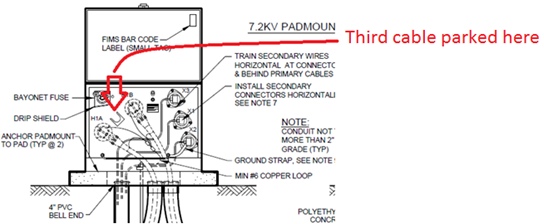Some background before we jump in. This discussion arises out of the different methods used to represent open points in an underground residential distribution (URD) loop. Of course the “loop” is radially fed, not actually “looped” by the fact that there are open point(s) present at padmount transformers – in the form of elbows placed in a stand-off position. Within the GIS the open point may be represented by a distinct point feature placed beside a transformer, or it may be an “elbow” feature with a normal position set to “open”.

There are multiple pros and cons to each approach. Without going into too much detail, use of an “Open Point” feature requires fewer features and a simpler network while use of “elbows” best supports some OMS applications that allow a user to change feature attributes but not to add, move or delete features.
All that being said, the question at hand is how to deal with cases where more than two cables enter the transformer housing.

Having them lead to the same “elbow” feature (as shown on the left below) will not suffice as both would be either open or closed when in practice one would be and the other not. Using the “open point” feature method will work.
So, what if you really need to (or really want to) make use of elbows for URD configuration. Then you might consider one of the configurations presented below. Though if you do, you might also consider additional (probably custom) logic that will ensure that all three elbows associated with the transformer are not closed at the same time.




